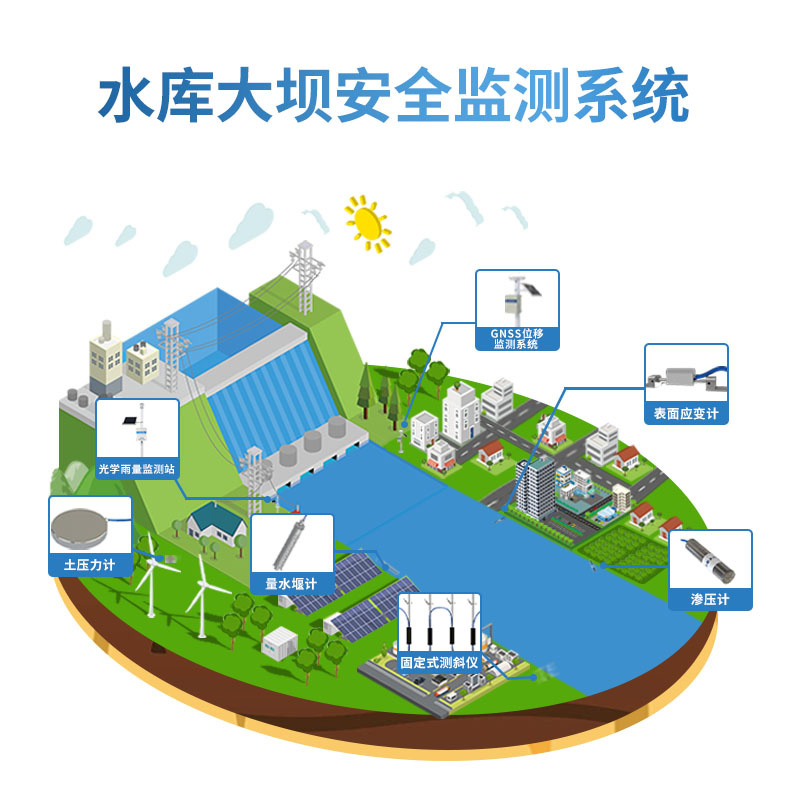Tianqiong Sensor IOT Technology Co., Ltd
Sales Manager:Ms. Emily Wang
Cel,Whatsapp,Wechat:+86 15898932201
Email:info@fengtutec.com
Add:No. 155 Optoelectronic Industry Accelerator, Gaoxin District, Weifang, Shandong, China

Sales Manager:Ms. Emily Wang
Cel,Whatsapp,Wechat:+86 15898932201
Email:info@fengtutec.com
Add:No. 155 Optoelectronic Industry Accelerator, Gaoxin District, Weifang, Shandong, China

Model:FT-DB1
Brand:tianqiong
1.Dam Monitoring Monitoring Background
Dam Monitoring can measure surface displacement, internal displacement, groundwater level, rainfall, retaining wall pressure, concrete stress, seepage, temperature and humidity, etc.The safe flood control of reservoirs has always been a difficult and key point in my country's flood control and flood control.The safe flood control of small and medium-sized reservoirs has become a weak link in the current national flood control work.Most reservoirs lack necessary safety monitoring and other facilities, and the inspection methods are backward and there are great hidden dangers.Once local heavy rainstorms and floods occur, it is very easy to cause dam collapse.At the least, it will cause property losses, and at the worst, it will cause major casualties or devastating disasters.
As of the end of 2018, 98,822 reservoirs of various types have been built nationwide.However, most small and medium-sized reservoirs were built in the 1960s and 1970s and are trilateral projects.On the one hand, most reservoirs have low flood control standards, poor project quality, severe siltation, and shrinking effective reservoir capacity, and are in a state of operation with illness.On the other hand, many reservoirs have reached or exceeded their designed service life and are seriously aging, and the potential safety hazards of reservoir projects are prominent.
2.Overview of Dam Monitoring System
In order to achieve my country's goal of building digital water conservancy, our company took the lead in closely combining cloud computing with the Internet of Things and established an intelligent, automated and informative reservoir dam safety online monitoring system, which has functions such as remote data transmission and real-time online monitoring and early warning, which plays a crucial role in ensuring the safe operation of reservoir dams.
3.Main monitoring content of Dam Monitoring
1.Surface displacement monitoring
2.Internal displacement monitoring
3.Groundwater level monitoring
4.Rainfall monitoring
5.Retaining wall pressure monitoring
6.Concrete stress monitoring
7.Seepage flow monitoring
8.Temperature and humidity monitoring
4.Dam Monitoring monitoring project list
| Monitoring items | Device name |
| Surface displacement | GNSS |
| Internal displacement | Series fixed inclinometer |
| Groundwater level | Pore water pressure gauge |
| Rainfall | Rain gauge |
| Retaining wall pressure | Soil pressure gauge |
| Concrete stress | Strain gauge |
| Seepage | Water meter |
| Temperature and humidity | Temperature and humidity sensor |
5.Dam Monitoring Monitoring Base
"Technical Specifications for Safety Monitoring of Concrete Dam DL/T 5178-2016"
"Technical Specifications for Safety Monitoring of Earth and Rock Dam SL551-2012"
"Technical Specifications for Safety Monitoring of Concrete Dam SL601-2013"
6.Dam Monitoring implements functions
1.The data can be displayed graphically, including water level flow relationship, water level process line, rainfall bar chart, osmotic pressure and seepage process line, time history curve chart, simulation chart, histogram, histogram, and other forms.
2.Real-time monitoring can be carried out in all weather conditions.
3.Once the monitoring data exceeds the preset value, timely warnings and notify relevant units to take corresponding measures immediately.
In the context of the increasingly accelerating urbanization process today, air quality has become one of the key elements for measuring the quality of life. However, due to the high construction and operation costs and fixed layout, traditional large-scale environmental monitoring stations find it...
China has a vast territory with complex and diverse geographical environments and significant differences in climatic conditions. As a crucial link for power transmission, transmission lines inevitably traverse special geographical areas such as valleys, high - altitude peaks, and rivers. These spec...
The crop growth condition is an important term in the agricultural field, referring to the growth and development status of crops at various stages from sowing to maturity. It includes comprehensive information such as plant morphology, population structure, and physiological indicators, and is cruc...
Wheat seedling conditions are usually classified into strong seedlings, robust seedlings (including first - class and second - class seedlings), and weak seedlings (third - class seedlings). For different seedling conditions, differential management measures need to be taken during key growth stages...